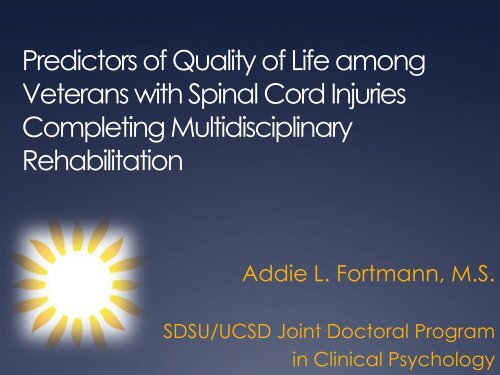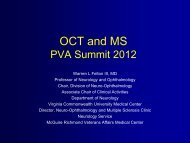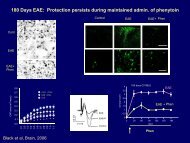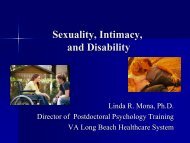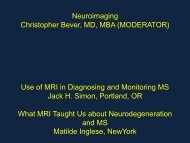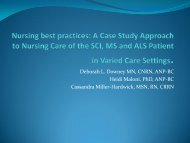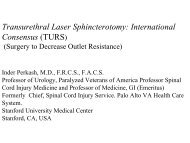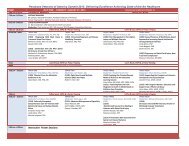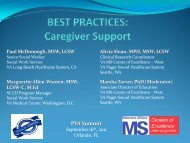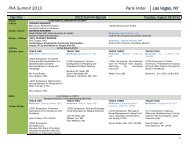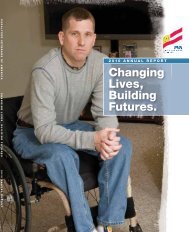Addie Fortmann, MS
Addie Fortmann, MS
Addie Fortmann, MS
Create successful ePaper yourself
Turn your PDF publications into a flip-book with our unique Google optimized e-Paper software.
Predictors of Quality of Life among<br />
Veterans with Spinal Cord Injuries<br />
Completing Multidisciplinary<br />
Rehabilitation<br />
<strong>Addie</strong> L. <strong>Fortmann</strong>, M.S.<br />
SDSU/UCSD Joint Doctoral Program<br />
in Clinical Psychology
Special Thanks to Coauthors<br />
‣ Thomas Rutledge, Ph.D. 1,2<br />
‣ Corey McCulloch, Ph.D. 1,2<br />
‣ Smriti Shivpuri, M.S. 3<br />
‣ Anne Nisenzon, Ph.D. 1<br />
‣ Jeri Muse, Ph.D. 1,2 1<br />
VA San Diego Healthcare System<br />
2<br />
UCSD, Department of Psychiatry<br />
3<br />
SDSU/UCSD Joint Doctoral Program in Clinical Psychology
DISCLOSURES SLIDE<br />
‣ This continuing education activity is managed and<br />
accredited by Professional Education Service Group.<br />
‣ The information presented in this activity represents the<br />
opinion of the author(s) or faculty.<br />
‣ Neither PESG, nor any accrediting organization endorses<br />
any commercial products displayed or mentioned in<br />
conjunction with this activity.<br />
‣ Commercial Support was not received for this activity.<br />
‣ No others have financial interests or relationships to<br />
disclose
LEARNING OBJECTIVES SLIDE<br />
‣ At the conclusion of this activity, the participant will<br />
be able to:<br />
‣ Describe change in quality of life among Veterans<br />
undergoing multidisciplinary rehabilitation for SCI.<br />
‣ Identify predictors of quality of life among Veterans at<br />
discharge from multidisciplinary rehabilitation for SCI.<br />
‣ Determine whether predictors of quality of life among<br />
Veterans with SCI differ across meaningful subgroups.
OUTLINE<br />
‣ Overview<br />
‣ Methodology<br />
‣ Findings<br />
‣ Consideration of the Bigger Picture<br />
‣ Closing
‣ SCI is a life-altering event<br />
OVERVIEW<br />
‣ Affects physical functioning, social relationships, role fulfillment,<br />
and self-perception<br />
‣ Initial rehabilitation is critical to help<br />
patients acquire the knowledge and<br />
skills necessary to live a satisfying life.<br />
‣ Early post-injury adjustment predicts<br />
long-term adjustment to SCI.<br />
‣ QOL is a central goal of SCI rehabilitation.<br />
‣ Assessing and predicting QOL outcomes after<br />
SCI has grown in importance.
DEFINING DISABILITY<br />
…some history<br />
‣ 1980: International Classification of Impairments,<br />
Disabilities, and Handicaps (ICIDH):<br />
‣ Impairment<br />
‣ Level and completeness of SCI<br />
‣ Disability<br />
‣ The restriction/lack of ability to perform within “normal”<br />
ranges<br />
‣ Handicap<br />
‣ A disadvantage that limits/prevents the fulfillment of<br />
“normal” roles
DEFINING DISABILITY<br />
. . .more recently<br />
‣ 2002: International Classification of Functioning,<br />
Disability, and Health (ICF)<br />
‣ Impairment<br />
‣ organ/body level<br />
‣ Activity Limitation<br />
‣ person level<br />
‣ Participation Restriction<br />
‣ societal level<br />
‣ Disability reflects ‘dysfunctionality’ at one or more levels.
DEFINING DISABILITY<br />
. . .more recently
Meta-Analysis: DISABILITY AND QOL<br />
‣ 1997: Dijkers, M. Quality of life after spinal cord injury: a meta<br />
analysis of the effects of disablement components. Spinal<br />
Cord.<br />
‣ Disablement was defined according to 1980 ICIDH<br />
conceptualization.<br />
‣ Reviewed 22 independent studies; average N =102.<br />
‣ Conclusions:<br />
ASSOCIATIONS WITH QOL (r)<br />
Impairment: Weak, rarely statistically significant [95% CI -0.12; 0.02]<br />
Disability: Somewhat stronger, but inconsistent [95% CI -0.27; -0.14]<br />
Handicap: Strongest and fairly consistent [95% CI -0.48; -0.17]
DISABILITY AND QOL<br />
‣ Limitations of Existing Research. . .<br />
‣ Meta-analysis collapsed across civilian and Veteran<br />
samples.<br />
‣ Veterans represent a disproportionate number of individuals<br />
in the US with SCI.<br />
‣ Conclusions about relative predictive utility were drawn<br />
across very diverse studies.<br />
‣ Cross-sectional design<br />
‣ Conducted at some point after initial<br />
inpatient rehabilitation
CURRENT STUDY<br />
‣ Aim 1: Describe change in QOL from pre- to postrehabilitation.<br />
PRE<br />
QOL<br />
POST<br />
QOL<br />
‣ Aim 2: Compare indicators of impairment, activity,<br />
and participation in prospectively predicting QOL<br />
post-rehabilitation.<br />
PRE<br />
Impairment,<br />
Activity,<br />
Participation<br />
POST<br />
QOL
METHODS<br />
‣ 118 Veterans entered CARF-accredited, acute inpatient<br />
rehabilitation for SCI at the SD VA Medical Center<br />
between 1998-2010.<br />
‣ Rehabilitation:<br />
‣ Individualized<br />
‣ Lasted up to several months<br />
‣ Involved many SCI-specific providers<br />
‣ Medicine, dietetics, nursing, psychology, social work, PT, OT,<br />
recreation therapy, speech therapy, etc.<br />
‣ IRB approval was obtained to conduct analyses.
MEASURES: QOL<br />
‣ Satisfaction with Life Scale (SWLS) was completed at<br />
admission and discharge.<br />
‣ Veteran’s subjective (global) assessment of his/her<br />
quality of life according to personally chosen criteria<br />
(i.e., “subjective QOL”).<br />
‣ Assesses how satisfied individuals are with their present<br />
status as compared to a standard each individual sets<br />
for him/herself.<br />
‣ 5 items, each scored 1 (strongly disagree) to 7<br />
(strongly agree).<br />
‣ Possible scores ranged from 5 to 35
MEASURES: QOL<br />
STRONGLY SLIGHTLY NEITHER AGREE SLIGHTLY STRONGLY<br />
DISAGREE DISAGREE DISAGREE OR DISAGREE AGREE AGREE AGREE<br />
‣ 1) In most ways my life is close to my ideal.<br />
‣ 2) The conditions of my life are excellent.<br />
‣ 3) I am satisfied with my life.<br />
‣ 4) So far I have gotten the important<br />
things I want in life.<br />
‣ 5) If I could live my life over, I would<br />
change almost nothing.
MEASURES: Disablement<br />
‣ Impairment:<br />
‣ Injury level (tetraplegia = 1; paraplegia = 0)<br />
‣ Completeness of injury (ASIA Impairment scale (A/complete<br />
= 1 to E/normal = 5).<br />
‣ Activity: Functional Independence Measure (FIM)<br />
‣ 18 items forming 3 subscales<br />
‣ Motor, Elimination, Cognition<br />
‣ Participation:<br />
‣ Craig Handicap Assessment and Reporting Technique<br />
(CHART)<br />
‣ 27 items forming 5 domains<br />
‣ Physical Independence, Mobility, Occupation, Social<br />
Integration, Economic Self-Sufficiency
RESULTS: Sample Characteristics<br />
Characteristic<br />
M (SD)<br />
Age (yrs) 43.2 (17.5)<br />
Percent<br />
Male 97.5%<br />
Caucasian 65.3%<br />
Admitted ≤ 60 days post-injury 80.0%<br />
Employed for wages 43.2%<br />
SU/psychiatric diagnosis 20.3%<br />
Sustained SCI in combat 2.5%<br />
Mechanism = MVA 29.7%
RESULTS: Study Variables<br />
Impairment<br />
Percent<br />
Tetraplegia 54.7%<br />
ASIA A 37.9%<br />
Activity<br />
M (SD)<br />
Cognition 31.4 (3.9)<br />
Motor 24.5 (13.5)<br />
Elimination 4.2 (3.8)<br />
Participation<br />
M (SD)<br />
Physical independence 98.6 (7.2)<br />
Mobility 94.3 (16.9)<br />
Occupation 85.4 (29.0)<br />
Social integration 93.4 (16.4)<br />
Economic self-sufficiency 87.2 (23.1)
RESULTS: Change in SWLS<br />
‣ GROUP LEVEL<br />
‣ p >.10<br />
SWLS<br />
Mean (SD)<br />
Admission 22.7 (7.3)<br />
Discharge 21.5 (7.8)<br />
‣ INDIVIDUAL LEVEL<br />
‣ Continuous<br />
‣ Range +17 to -22 points; Individual Mean Δ=+1.2 (6.0)<br />
‣ Categorical (scores ≥20 reflect “at or above average SWL”)<br />
‣ 14% at or above average to below average<br />
‣ 17% below average to at or above average<br />
‣ 69% remained in the same category
RESULTS: Change in SWLS
RESULTS: Predicting SWLS at Discharge<br />
BASELINE INDICATOR SWLS AT DISCHARGE (r)<br />
Impairment<br />
Injury level -0.04<br />
Injury completeness -0.02<br />
Activity<br />
Cognition 0.31*<br />
Motor -0.03<br />
Elimination 0.12<br />
Participation<br />
Physical independence 0.04<br />
Mobility 0.09<br />
Occupation 0.11<br />
Social integration 0.21*<br />
Economic self-sufficiency 0.16
RESULTS: Predicting SWLS at Discharge<br />
Linear regression model including predictors that were statistically<br />
significant at the bivariate step.<br />
PREDICTOR<br />
β<br />
Admission SWLS 0.65*<br />
Activity<br />
Cognition 0.17*<br />
Participation<br />
Social integration 0.01<br />
Economic self-sufficiency -0.02<br />
45%<br />
+2%
RESULTS: Exploratory Analyses<br />
‣ Fit of the FIM cognition (activity) predictor did<br />
not vary by meaningful subgroups. . .<br />
‣ Age median split<br />
‣ Tetraplegia vs. Paraplegia
RECAP OF FINDINGS<br />
‣ Marked variability was observed across individuals in<br />
the magnitude and direction of QOL changes.<br />
‣ Activity (cognition) and participation (social<br />
integration, economic self-sufficiency) predicted QOL<br />
at discharge.<br />
‣ Consistent with 1997 meta-analysis findings that disability<br />
and handicap were the strongest predictors of QOL.<br />
‣ When entered jointly, activity (cognition) emerged as<br />
the most robust predictor.<br />
‣ In contrast to 1997 meta-analysis findings that handicap<br />
was most consistently associated with QOL.
GRAND SCHEME OF THINGS. . .<br />
‣ Cognitive Impairment<br />
‣ Cognitive screening is a standard component of acute<br />
SCI rehabilitation at the VA Medical Center<br />
‣ Veterans referred for cognitive rehabilitation to reduce<br />
functional interference as indicated.<br />
‣ Cognitive assessment and rehabilitation<br />
tools must be flexible and incorporate<br />
modifications for SCI populations.
GRAND SCHEME OF THINGS. . .<br />
‣ Social Integration<br />
‣ Programs providing assistance in building new and/or<br />
mobilizing existing social support resources.<br />
‣ Support groups and peer-mentor programs<br />
encourage Veterans to integrate with<br />
others who are coping with similar<br />
adjustment difficulties.<br />
‣ Consistent with large body of<br />
research indicating the importance<br />
of social networks in health.
Importance of Early Adjustment<br />
‣ Directly targeting various aspects of emotional wellbeing,<br />
including perceived QOL<br />
‣ Rehabilitation Psychology 2011 Systematic Review<br />
‣ Supported the use of specialized CBT protocols in persons<br />
with SCI experiencing depression, anxiety, and<br />
adjustment/coping difficulties.<br />
‣ Telecounseling interventions<br />
‣ Increase access, time-efficiency, and cost-effectiveness<br />
‣ Valuable method for reaching pts with limited mobility<br />
‣ Shown to improve QOL, coping skills, community integration,<br />
and depression in individuals with SCI and other acquired<br />
physical disabilities.
Limitations<br />
‣ Findings pertain to a particular definition/measure<br />
of (subjective) QOL – life satisfaction<br />
‣ What about adjustment after inpatient<br />
rehabilitation?<br />
‣ Limitations of predictor and outcome measures<br />
‣ Focused narrowly on components of disablement
IN CLOSING<br />
‣ First investigation of the relative utility of impairment,<br />
activity, and participation in predicting QOL<br />
among Veterans completing acute rehabilitation<br />
for SCI.<br />
‣ Findings highlight potential targets for interventions<br />
aiming to improve QOL post-SCI among US<br />
Veterans.<br />
‣ Results suggest that rehabilitation settings should<br />
continue (or expand upon) programs targeting<br />
cognitive functioning and social integration.
THANK YOU!<br />
‣ If you would like to receive continuing education<br />
credit for this activity, please visit<br />
http://www.pesgce.com/PVA2012


